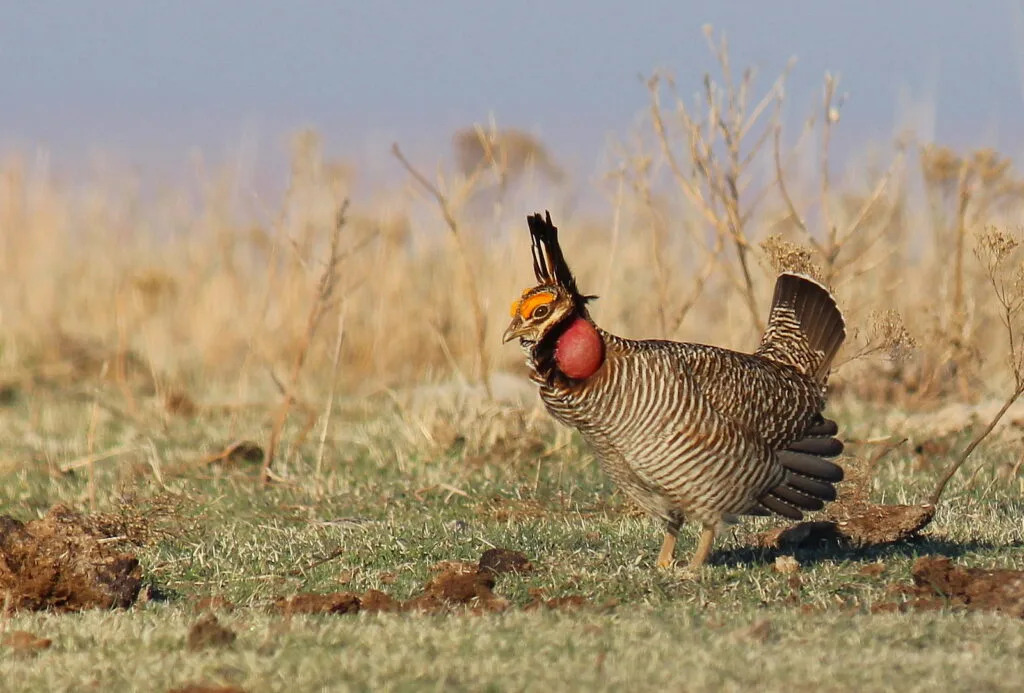
Endangered Species Act protections for the lesser prairie chicken, which resides in Kansas' grasslands, were removed after petroleum and agricultural industries challenged those protections in court. (Photo by Greg Kramos / U.S. Fish and Wildlife Service)
TOPEKA — The lesser prairie chicken, a dancing grouse that has long teetered between threatened and endangered classifications, lost its federal protections in court in a victory for Great Plains petroleum and cattle industries.
In a Tuesday decision from a Texas federal court, the lesser prairie chicken was stripped of any endangered or threatened species protections, which were established through a Biden-era ruling.
The Trump administration challenged that ruling, arguing it contained mistakes, and the lesser prairie chicken would be adequately protected without endangered or threatened classifications.
U.S. District Judge David Counts, a Trump appointee, agreed, denying a slate of motions in a 15-page omnibus order that reversed the U.S. Fish and Wildlife Service’s 2022 classifications.
The lesser prairie chicken forages on what’s widely considered to be prime ranching and drilling land in the grasslands and brush of southwestern Kansas, southeastern Colorado, eastern New Mexico, western Oklahoma and the panhandle and south plains of Texas. The bird was first protected in 2014, a decision that was overturned a year later.
In the 2022 classifications, the bird’s populations were divided into a southern range in New Mexico and the southwest Texas Panhandle, where it was listed as endangered, and a northern range in Kansas, Oklahoma and the northeast Texas Panhandle, where it was listed as threatened.
More than 70% of the estimated lesser prairie chicken population resides in Kansas.
Fish and Wildlife Service admitted in the case that it erred in creating two distinct populations of lesser prairie chickens, and it failed to justify the classification of the two distinct population segments — northern and southern, Counts said.
He added that “the later endangered and threatened findings have no leg to stand on.”
“Fish and Wildlife is unable to correct this square one error without engaging in an entirely new analysis,” he said.
Counts reasoned that any “disruptive consequences” of removing protections “are short-lived and minimized by the sixteen existing voluntary conservation programs and efforts in place across the range of the lesser prairie-chicken.”
Many of those programs, which are administered by federal, state and private groups, existed before the 2022 listing decision and were designed to mitigate threats to the lesser prairie chicken and its habitat, Counts said.
“These efforts are not thought to be inadequate over the short term,” he said. “Rather, even the current listing decision couched their inadequacies in the long term — a span of 25 years.”
The decision is a win for Kansas agricultural and energy producers, said U.S. Rep. Tracey Mann, who has publicly opposed listing the lesser prairie chicken since 2021. He added it is “a huge loss for radical climate activists and bureaucrats who have abused the Endangered Species Act for over a decade to hurt American agriculture and energy production.”
“Kansas farmers, ranchers and agricultural producers have always been and always will be the original conservationists of the land,” he said.
Mann was behind a bill this year that delisted the lesser prairie chicken and prevented any future efforts to relist it. However, the legislation did not progress.
Matt Teagarden, CEO of the Kansas Livestock Association, said in an emailed statement that the 2022 ruling contained “significant flaws” that “disproportionately affected livestock operations.” He said the association, which was part of the lawsuit, is pleased the Trump administration is reexamining the listing.
“Over the coming months,” he said, “we hope the U.S. Fish and Wildlife Service will take into account the voluntary conservation efforts already taking place, most of which are being done by ranchers.”
Texas agencies initially sued the Fish and Wildlife Service in March 2023. Among them was the state’s railroad commission, which regulates oil and natural gas production in the state. Attorneys general in Kansas and Oklahoma and the petroleum and cattle industries later joined the suit.
Kansas Attorney General Kris Kobach and Oklahoma Attorney General Gentner Drummond celebrated the decision.
“The listing of the species as threatened or endangered would have crippled oil and wind energy production and would have limited where and when Kansas ranchers could graze cattle on their own property,” Kobach said in a Friday news release.
Drummond said in a Wednesday news release that he had called the Biden administration’s ruling “outrageous and illegal federal overreach.”
“This court decision affirms we were right,” Drummond said. “Oklahoma’s cattle grazing, energy production and rural economy are no longer under siege by this unlawful regulation.”
In Kobach’s initial argument in federal court, he worried Kansas would lose revenues from cattle ranching, farming, oil and gas production, wind energy production and tourism if the lesser prairie chicken’s threatened status stood. He worried the status would lead to job losses in the state, which would “further adversely impact state tax revenues, in addition to causing social instability among Kansans who lose their jobs.”
Under the Endangered Species Act, the habitat and species protections that accompany a threatened or endangered status determination curtail certain land uses such as cattle ranching, oil drilling and energy production in protected habitats.
Jason Rylander, legal director of the Center for Biological Diversity’s Climate Law Institute, which was an intervenor in the case, said the Trump administration’s rationale for removing the lesser prairie chicken’s protections was in bad faith.
“This ruling has nothing to do with science or the law and everything to do with kowtowing to the oil and gas industry,” he said. “We won’t be silent witnesses while the Trump administration and fossil fuel companies try to carve up what’s left of these dancing birds’ habitat and doom them to extinction.”
But the fight for the lesser prairie chicken is not over, Rylander said.
The institute is considering its legal options, including a possible appeal of Counts’ decision and a new petition with the USFWS to relist the lesser prairie chicken.






Comments